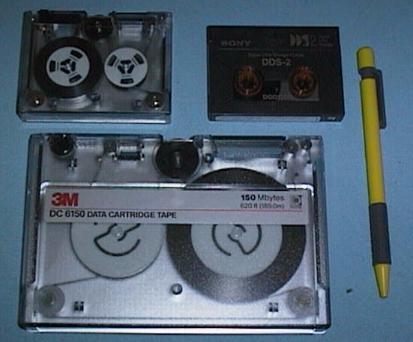

Magnetic tape storage technology dates back to the early days of computers, you will often see computers in old films with lots of flashing lights and big reels of magnetic tape whizzing around. These were nine-track reel-to-reel tape systems and the oldest examples had a track density of 1,600 bits per inch (25mm) of tape but this increased to 6,250 bits per inch by 1982. Using a 12 inch (300mm) reel of tape this provided about 225MByte of storage. These systems were quite reliable if the drives were kept clean and this was the standard way of transporting data between computer systems.
During the 1980's the development of Desk Top Computers meant the reel-to-reel format gave way to various Cartridge formats but these suffered read-write compatibility problems when tapes were taken from one drive to another. From about 1985 to 1995, the most popular data tapes were QIC (Quarter Inch Cartridge) and over these years many different formats were made available in QIC tape.
Two different size QIC cartridges are available.(see the illustration below). The older, larger cartridge, was originally used in tape drives that required a SCSI interface and were mostly used in file server applications and on Mini Computers. These larger cartridges were used at a wide range of capacities, the names of the formats include, QIC-24, QIC-150, QIC-525, QIC-1000, QIC-2GB, FA-500, QFA-700.

The most popular tape back-up technology for desk top PC's from 1990 to 1995 used the smaller QIC cartridge. Low cost tape backup for the PC computer was introduced in 1990 with QIC-40 tape drives that interfaced via the Floppy Disk Controller, and provided 60 or 120 Megabyte of storage. The QIC-40 drives gave away to QIC-80 drives with twice the capacity, obtained by using more tracks across the tape and writing at a higher data density. The native capacity of a QIC-80 tape was 125 Megabyte and the compressed capacity was 250 Megabyte The QIC tape format was made redundant by first the TRAVAN T-1000, and then the Travan TR-4 standard. QIC-40 and QIC-80 used a small cartridge that was about the size of an Audio Compact Cassette but about twice as thick. The QIC-40/80 cartridges contained either 205 feet or 307 feet of quarter inch magnetic tape. The QIC-80 standard continued to evolve in a series of steps through QIC-80Wide (with more tracks across the tape), and QIC-80XL.
The TRAVAN format, was based on the QIC standards but used a tape that was longer and wider than the QIC-40 and QIC-80 tapes. Travan soon took over from QIC-80 and QIC-40 these technologies are only a memory. 307 feet (93.7M) QIC 40 provided 60 Megabyte native while QIC 80 provided 120Megabyte native. The compressed capacity of each format was double the native capacity.
T-1000 provided 400 MByte of uncompressed storage, (800 MB with compression) and was read/write compatible with QIC-80, QIC-80 Wide, QIC-80 XL, and read compatible with QIC-40 media.
These tape formats use the same MFM encoding method used for storing data on a floppy disk. The highest data transfer rate available from a Floppy Disk Controller is the same rate as used for High Density Floppy disks and this is 500 Kbits per second. The manufacturers of the tape drives also made available an alternative "tape only" controller that could be used at a data rate of 1 Megabyte per second.
Most tape drives that used the large cartridge QIC formats used a SCSI interface and this necessitated fitting a SCSI interface card to the computer.
Data can be stored on the tape in either Uncompressed (Native capacity) or Compressed format. The tape back-up software supplied with the tape drives provides a software compression and gives the option of storing data in either way. Some of the "tape only" controllers available from the tape drive manufacturers also provide a more advanced compression using a compression controller chip (a STAC chip) on the controller.
Initially the 4mm wide DDS tape provided a storage capacity of up to 1.3GByte and a transfer rate of 180 KBytes per second. The tape was made longer and the recording density was increased and eventually DDS provided up to 12 GByte of Uncompressed storage space.
Since it was introduced in 1994 DLT technology has evolved from an Uncompressed capacity of 10 GByte to 35 GByte with further development still going on..
| QIC tape | TRAVAN TR-4 | DAT Tape | Back to the opening index | Book four index |